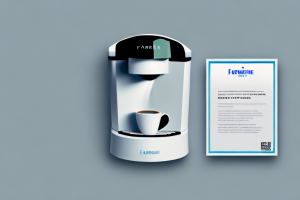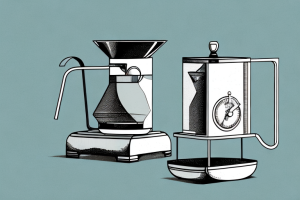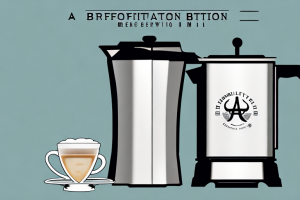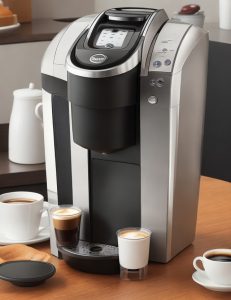Coffee Maker Japan

A traditional japanese-style coffee maker
Coffee has become an integral part of many people’s lives, and the coffee maker has played a significant role in ensuring the perfect cup of coffee is made every time. Japan, known for its precision and craftsmanship, is home to some of the best coffee makers worldwide, with a long history and a range of options that cater to diverse needs. In this article, we will explore the history, types, benefits, and innovation of Japanese coffee makers in detail, along with other topics of interest concerning this device. Sit tight, grab a cup of coffee and enjoy reading through this insightful piece.
The history and evolution of coffee makers in Japan
Coffee makers have been a part of Japanese culture for many years. The Rancilio Group, an Italian manufacturer of coffee machines and products, played a significant role in the birth of coffee machines in Japan. They introduced espresso machines to Japan in the 1920s, and soon after, other companies such as Hario, Kalita, and Chemex began producing coffee makers tailored to suit their unique style and preferences. Japanese coffee makers range from automatic drip machines to pour over devices and specialty siphon makers.
One of the most popular types of coffee makers in Japan is the pour over device. This method involves pouring hot water over coffee grounds in a filter, allowing the water to slowly drip through and extract the flavor. The Hario V60 and Kalita Wave are two popular pour over devices that have gained a cult following in Japan and around the world. In recent years, there has also been a resurgence of interest in traditional siphon coffee makers, which use a vacuum-like process to brew coffee. These unique and intricate devices have become a symbol of Japanese coffee culture and are often found in specialty coffee shops and cafes.
A guide to the different types of Japanese coffee makers available
Drip coffee maker, vacuum coffee maker, manual pour over coffee dripper, immersion brewer, and single-serve coffee maker are all examples of the various types of coffee makers you can find in Japan. While the drip coffee maker is the most common type, many coffee fans in Japan prefer the pour-over, which offers a slower brewing process that allows for maximum flavor extraction. Specialty siphon makers are also popular, reflecting Japan’s attention to detail and dedication to precision brewing. These different types are designed to cater to various tastes, preferences, and lifestyles.
It’s worth noting that Japanese coffee makers are often designed with aesthetics in mind, as well as functionality. Many of them feature sleek, minimalist designs that fit in well with modern Japanese homes and kitchens. Additionally, some coffee makers are specifically designed for use with Japanese coffee beans, which are known for their unique flavor profiles and high quality. Whether you’re a coffee aficionado or just looking for a convenient way to make a cup of joe, there’s a Japanese coffee maker out there that’s perfect for you.
How to choose the best Japanese coffee maker for your needs
Choosing a Japanese coffee maker that caters to your needs can be a little tricky, especially if you’re not familiar with every option available. Consider factors such as the type of coffee you prefer, your budget, capacity, space limitations, and the time you’re willing to spare to make a cup of coffee. Manual coffee drippers are affordable and produce a high-quality brew, but they require a little more attention and effort than automatic drip makers. On the other hand, automatic drip coffee makers deliver quick and convenient coffee without the hassle of manual operation. Still, they need to be switched off and unplugged to avoid wasting electricity. Your taste and preference is what will most likely determine the choice you make at the end of the day.
Another important factor to consider when choosing a Japanese coffee maker is the material it is made of. Some coffee makers are made of plastic, while others are made of glass or stainless steel. Plastic coffee makers are lightweight and affordable, but they may not be as durable as glass or stainless steel. Glass coffee makers are elegant and easy to clean, but they can be fragile and may break easily. Stainless steel coffee makers are durable and long-lasting, but they can be more expensive than other materials. Consider the pros and cons of each material and choose the one that best suits your needs and preferences.
Top 10 Japanese coffee makers you should know about
Given the range of options available, this list could go on and on. However, we’ve compiled a list of the top ten Japanese coffee makers you should know about. These coffee makers have been tried and tested, and consumers recommend them for their affordability, convenience, specialty brewing techniques, and unique features. They include the Hario V60 drip coffee maker, the Kalita Wave coffee maker, AeroPress, Siphon Coffee Maker, Bonavita BV1900TS, and many others. Each coffee maker on this list ensures that you get a perfect cup of coffee every time.
One of the most popular Japanese coffee makers is the Hario V60 drip coffee maker. It is known for its unique design that allows for a slow and even extraction of coffee, resulting in a rich and flavorful cup. The Kalita Wave coffee maker is another favorite among coffee enthusiasts. Its flat-bottomed design ensures an even extraction and a clean taste.
If you’re looking for a more portable option, the AeroPress is a great choice. It’s compact and easy to use, making it perfect for travel or camping trips. For those who enjoy a more theatrical coffee-making experience, the Siphon Coffee Maker is a must-try. It uses a vacuum brewing method that creates a mesmerizing visual display while producing a smooth and flavorful cup of coffee.
The benefits of using a Japanese coffee maker over other brands
Japanese coffee makers are known for their precision and top-of-the-line designs. They offer convenience, unique brewing techniques, affordability, and durability. Many Japanese coffee makers are manual, offering more control, precision, and attention to detail during the brewing process. Others such as automatic drip coffee makers, provide speed, convenience, and consistency. Most importantly, each coffee maker is crafted with the user in mind, ensuring their brewing experience is top-notch.
Additionally, Japanese coffee makers often incorporate traditional Japanese elements into their designs, such as bamboo handles or ceramic materials. This not only adds to the aesthetic appeal of the coffee maker but also reflects the cultural significance of coffee in Japan. Furthermore, Japanese coffee makers are often eco-friendly, with many brands using sustainable materials and offering reusable filters. By choosing a Japanese coffee maker, not only are you getting a high-quality brewing experience, but you are also making a conscious effort to reduce your environmental impact.
A step-by-step guide to brewing the perfect cup of coffee with a Japanese coffee maker
Once you’ve chosen your coffee maker, it’s time to start brewing the perfect cup of coffee. Here’s a quick guide to brewing your perfect cup of coffee:
- Measure and grind your coffee beans.
- Preheat the coffee maker and filter by adding hot water and discard the water after 30 seconds.
- Put ground coffee in the filter and pour over hot water in a circular motion, ensuring all coffee grounds are saturated.
- Allow the coffee to brew for three to four minutes.
- After brewing, pour your coffee in a mug, and enjoy!
Cleaning and maintaining your Japanese coffee maker for long-lasting use
Cleaning and maintaining your coffee maker is essential for optimal performance and durability. Start by cleaning your coffee maker after every use and descaling it once every month. Use a mixture of vinegar and water to remove any coffee residues, and avoid using abrasive cleaning detergents. Check your coffee maker’s manual for more comprehensive instructions on maintenance and cleaning procedures.
The cultural significance of coffee in Japan and its influence on coffee maker design
Coffee has become part of Japan’s cultural landscape. In Japan, coffee is consumed for its flavor and aesthetic value and represents a lifestyle statement. It is served in high-end restaurants and coffee shops, and the brewing process is elevated to an art form. Given this cultural significance, coffee makers’ design and craftsmanship reflect Japan’s culture and values, precision, and attention to detail.
The future of Japanese coffee makers: innovation and sustainability trends
Japanese manufacturers continue to innovate and push the boundaries of coffee makers’ designs and features. From environmentally-friendly materials to smart coffee makers that can be controlled with a smartphone app, the future of Japanese coffee makers looks promising. Innovations that place sustainability and eco-friendliness at the forefront of production are also on the rise, marking a positive move towards environmentally-friendly practices within the industry.
Comparing prices: how much does a Japanese coffee maker cost compared to other brands?
The prices of Japanese coffee makers vary, depending on the type, capacity, and special features. Generally, Japanese coffee makers are competitively priced with other brands, and you can find an excellent quality coffee maker from around $20 to $300. Some artisanal and specialty coffee makers can be more expensive, ranging between $500 to $1,500. Researching and comparing the prices of various coffee makers is essential in identifying the most affordable and suitable coffee maker for your brewing needs.
Reviews and ratings: what do customers say about their experience with Japanese coffee makers?
Customers have given Japanese coffee makers positive ratings based on their brewing experience, convenience, and durability. Most customers love the unique brewing techniques, precision, and control offered by manual coffee makers such as pour-over drippers. Automatic drip coffee makers are also popular for their convenient and consistent coffee output. Japanese coffee makers have become a staple in many households worldwide, and their high customer satisfaction ratings reflect their popularity and quality.
How to troubleshoot common issues with your Japanese coffee maker.
Although Japanese coffee makers are designed with the user in mind, issues such as clogging, leaking, and malfunctioning can occur. However, identifying the problem and finding a quick fix is essential to ensure long-lasting use of your coffee maker. Check your coffee maker’s manual for troubleshooting information or visit the manufacturer’s website for more information. If all else fails, contact the manufacturer’s customer service for assistance.
The impact of COVID-19 on the production and distribution of Japanese coffee makers.
The COVID-19 pandemic affected several industries worldwide, including coffee maker production and distribution. The pandemic caused disruptions in international trade, which affected the shipping and delivery of coffee makers. Some manufacturers temporarily closed their factories while others switched to online commerce, causing delays in product availability and delivery. However, many coffee makers have resumed production and implemented social distancing measures to ensure the safety of their employees.
Where to buy authentic, high-quality Japanese coffee makers online or in-store?
You can purchase Japanese coffee makers from various online and in-store retailers. Check out online marketplaces such as Amazon, Alibaba, or eBay, or visit the Japanese manufacturer’s website to buy directly from the source. You can also find Japanese coffee makers in specialty coffee shops, department stores, and kitchenware shops. Buying from verified sellers and authentic distributors assures you of high-quality and genuine Japanese coffee makers.
In conclusion, Japanese coffee makers have come a long way, and their unique designs and features have contributed to the evolution of coffee makers worldwide. By understanding the history, types, benefits, and innovation of Japanese coffee makers, you can choose the best coffee maker for your coffee brewing needs. Follow our step-by-step guide to brewing the perfect cup of coffee and maintain and clean your coffee maker for long-lasting use. From manual drip coffee makers to automatic drip machines, Japanese coffee makers cater to every taste and preference. Invest in a Japanese coffee maker today and elevate your coffee brewing experience.



